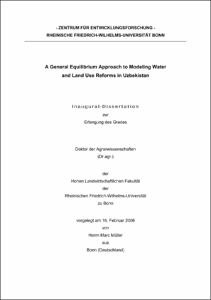Müller, Marc: A General Equilibrium Approach to Modeling Water and Land Use Reforms in Uzbekistan. - Bonn, 2006. - Dissertation, Rheinische Friedrich-Wilhelms-Universität Bonn.
Online-Ausgabe in bonndoc: https://nbn-resolving.org/urn:nbn:de:hbz:5N-08015
Online-Ausgabe in bonndoc: https://nbn-resolving.org/urn:nbn:de:hbz:5N-08015
@phdthesis{handle:20.500.11811/2376,
urn: https://nbn-resolving.org/urn:nbn:de:hbz:5N-08015,
author = {{Marc Müller}},
title = {A General Equilibrium Approach to Modeling Water and Land Use Reforms in Uzbekistan},
school = {Rheinische Friedrich-Wilhelms-Universität Bonn},
year = 2006,
note = {In 2000 and 2001, agricultural producers in Uzbekistan were severely affected by the worst draught of the last two decades. Since the agricultural sector depends mainly on the availability of irrigation water, the draught harmed the income of the rural population, for which the agricultural sector is the main employer. The question arises, why the irrigation system was extended so far and why such a high share of the population depends on the agricultural sector. This question is of particular importance because the government of Uzbekistan has attempted to foster the development of non-agricultural sectors and the gradual economy-wide reform towards market-orientation since independence in 1992. One instrument of this political goal is a system of regulations concerning the domestic cotton market. This system imposes production targets and administrative prices on the producers, who, on the other hand, benefit from subsidized inputs. The raw cotton is then further processed into fibre, which is a relevant source of foreign-exchange earnings. These earnings are then used to import investment goods, which have a high share in the total import volume. These imports of investment goods stand in contrast to the stable employment-share of the different economic sectors. In order to gain a better understanding of the feedbacks between economic sectors and the government, the general framework of the Uzbek economy is described in chapter 2 and the application of a general equilibrium model is proposed. The applicability and the properties of such a model-approach are then discussed in chapter 3. The compilation of a consistent database from different and sometimes contradicting sources is particularly important here. The implemented model is then used to simulate several scenarios in chapter 4, which focuses on the cotton-market regulations. This eventually shows that agricultural producers do not necessarily benefit from a liberalization of the cotton market.},
url = {https://hdl.handle.net/20.500.11811/2376}
}
urn: https://nbn-resolving.org/urn:nbn:de:hbz:5N-08015,
author = {{Marc Müller}},
title = {A General Equilibrium Approach to Modeling Water and Land Use Reforms in Uzbekistan},
school = {Rheinische Friedrich-Wilhelms-Universität Bonn},
year = 2006,
note = {In 2000 and 2001, agricultural producers in Uzbekistan were severely affected by the worst draught of the last two decades. Since the agricultural sector depends mainly on the availability of irrigation water, the draught harmed the income of the rural population, for which the agricultural sector is the main employer. The question arises, why the irrigation system was extended so far and why such a high share of the population depends on the agricultural sector. This question is of particular importance because the government of Uzbekistan has attempted to foster the development of non-agricultural sectors and the gradual economy-wide reform towards market-orientation since independence in 1992. One instrument of this political goal is a system of regulations concerning the domestic cotton market. This system imposes production targets and administrative prices on the producers, who, on the other hand, benefit from subsidized inputs. The raw cotton is then further processed into fibre, which is a relevant source of foreign-exchange earnings. These earnings are then used to import investment goods, which have a high share in the total import volume. These imports of investment goods stand in contrast to the stable employment-share of the different economic sectors. In order to gain a better understanding of the feedbacks between economic sectors and the government, the general framework of the Uzbek economy is described in chapter 2 and the application of a general equilibrium model is proposed. The applicability and the properties of such a model-approach are then discussed in chapter 3. The compilation of a consistent database from different and sometimes contradicting sources is particularly important here. The implemented model is then used to simulate several scenarios in chapter 4, which focuses on the cotton-market regulations. This eventually shows that agricultural producers do not necessarily benefit from a liberalization of the cotton market.},
url = {https://hdl.handle.net/20.500.11811/2376}
}






